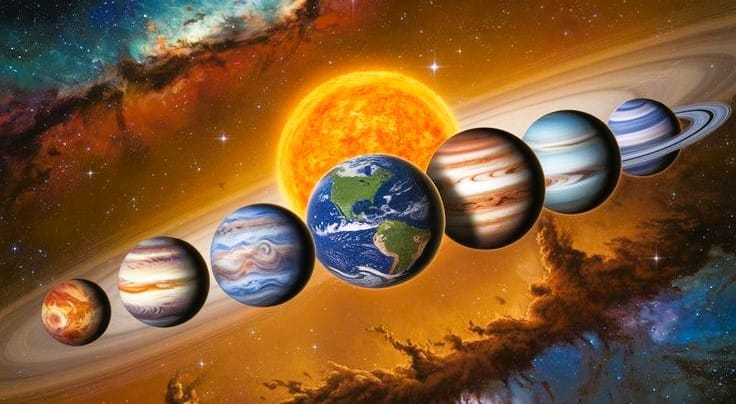Six Planetary Alignments are among the most fascinating celestial events to observe. When several planets appear to line up in the night sky, it creates a breathtaking spectacle that captivates stargazers worldwide. While such alignments might seem magical, there’s a lot of science behind them. This article explores the science of planetary alignments, focusing on the rare and exciting six-planet alignment and why it’s worth understanding.
What Is a Planetary Alignment? : Six Planetary Alignments
A planetary alignment occurs when planets in our solar system appear to line up from our perspective on Earth. These alignments do not mean the planets are in a perfectly straight line in space; instead, they appear that way due to their positions relative to Earth.
The solar system’s planets orbit the Sun in elliptical paths, and their distances and orbital speeds vary. When multiple planets move into similar areas of the sky, they create what we call an alignment.
What Makes the Six-Planet Alignment Special?
The six-planet alignment is a rare event because it involves a significant number of planets visible together in the same portion of the sky. This event typically includes Mercury, Venus, Mars, Jupiter, Saturn, and Uranus or Neptune, depending on visibility conditions.
Such alignments don’t happen frequently. While partial alignments (involving three or four planets) are more common, a six-planet alignment can take decades to occur. The rarity of this event makes it a must-see for astronomers and enthusiasts alike.
Why Do Planetary Alignments Occur? : Six Planetary Alignments
Planetary alignments occur due to the predictable orbits of planets around the Sun. Every planet has a unique orbital period, and their positions relative to one another change over time. Occasionally, their orbits bring them into positions where they appear clustered together in the sky.
For example:
- Mercury completes an orbit around the Sun in about 88 days.
- Venus takes approximately 225 days.
- Mars, being farther from the Sun, takes about 687 days.
- Jupiter and Saturn take even longer—12 and 29 years, respectively.
These differing orbital speeds mean the planets align in various groupings at specific intervals. However, achieving a six-planet alignment requires precise timing and conditions, which is why it’s so rare.
How to Observe a Six-Planet Alignment

Observing a six-planet alignment doesn’t require a telescope, though having one can enhance the experience. Here’s how to prepare:
- Know the Date: Planetary alignments are predicted well in advance. Use astronomy apps or websites to find the exact dates for upcoming alignments.
- Pick the Right Location: Choose a spot with minimal light pollution, like a rural area or a hilltop. Clear skies are essential for a good view.
- Timing Matters: The best time to observe alignments is usually just before dawn or after sunset when the sky is dark, and the planets are bright.
- Use Binoculars or a Telescope: While planets like Venus and Jupiter are easily visible to the naked eye, binoculars or a telescope can help spot fainter planets like Uranus or Neptune.
- Stay Updated: Follow astronomy forums and news to get real-time updates on visibility conditions.
The Science of Why We See Alignments : Six Planetary Alignments
From Earth, we observe planets along an imaginary line in the sky called the ecliptic plane. This line represents the plane of Earth’s orbit around the Sun, and all other planets in our solar system orbit within or near this plane.
When planets appear to cluster along the ecliptic, it creates the illusion of alignment. The alignment’s visibility depends on the planets’ positions relative to Earth.
Myths and Misconceptions About Planetary Alignments : Six Planetary Alignments
Planetary alignments have been the subject of myths and superstitions for centuries. Some believe they cause natural disasters or significant changes on Earth. However, science debunks these claims.
- Gravitational Effects: While the combined gravitational pull of aligned planets exists, it is negligible. The Moon’s gravity has a far greater effect on Earth than all the planets combined.
- End-of-the-World Predictions: Many end-of-the-world theories tied to alignments have been proven false. Planetary alignments are natural occurrences with no catastrophic consequences.
- Astrological Beliefs: While astrology assigns meaning to planetary alignments, these interpretations lack scientific evidence. Astronomy focuses on the factual movements of celestial bodies.
Fun Facts About Planetary Alignments : Six Planetary Alignments
- They’re Predictable: Astronomers can calculate planetary alignments thousands of years into the past or future.
- Perfect Alignments Are Impossible: Because planets orbit at different inclinations, a perfectly straight alignment in space will never occur.
- Historical Observations: Ancient civilizations, such as the Mayans and Babylonians, documented planetary alignments, associating them with significant events.
Why Study Planetary Alignments? : Six Planetary Alignments
Studying planetary alignments helps scientists better understand orbital mechanics and the dynamics of our solar system. Observing these events also inspires curiosity and appreciation for the vastness of space.
For amateur astronomers, alignments provide an excellent opportunity to observe multiple planets in one night. It’s also a chance to connect with others who share an interest in the cosmos.
How to Capture a Six-Planet Alignment
If you’re interested in astrophotography, a six-planet alignment is a fantastic subject. Here are some tips for capturing the event:
- Use a Tripod: A stable base is essential for long-exposure shots.
- Choose the Right Lens: A wide-angle lens is ideal for capturing the alignment, while a zoom lens can focus on individual planets.
- Adjust Camera Settings: Use a high ISO setting and a slow shutter speed to capture faint planets. Experiment to find the right balance.
- Include the Landscape: Adding a foreground element, like mountains or trees, can make your photo more visually appealing.
- Edit Your Photos: Post-processing software can enhance details and colors in your images.
Upcoming Six-Planet Alignments
To catch the next six-planet alignment, keep an eye on astronomy calendars and alerts. The event’s rarity makes it a once-in-a-lifetime opportunity for many.
The Six-Planet Alignment in 2025
In 2025, skywatchers will have the opportunity to witness a remarkable six-planet alignment. On January 21, Mars, Jupiter, Uranus, Neptune, Venus, and Saturn will align in the evening sky. Of these, Mars, Jupiter, Venus, and Saturn will be visible to the naked eye, while Uranus and Neptune will require binoculars or a telescope for observation.
This event is significant due to its rarity. While smaller alignments involving three or four planets occur more frequently, a six-planet alignment is uncommon and offers a unique spectacle for observers.
Observing the 2025 Six-Planet Alignment
To make the most of this celestial event:
- Timing: The alignment will be visible just after sunset on January 21, 2025. The optimal viewing time is around 19:00 UTC.
- Location: Find a location with a clear view of the horizon and minimal light pollution. Rural areas or elevated spots are ideal.
- Equipment: While Mars, Jupiter, Venus, and Saturn can be seen with the naked eye, bringing binoculars or a telescope will enhance your experience, especially for viewing Uranus and Neptune.
- Weather: Check the local weather forecast to ensure clear skies during the event.
Historical and Future Alignments : Six Planetary Alignments

Planetary alignments have fascinated humans for centuries. The last notable six-planet alignment occurred in June 2022, when Mercury, Venus, Mars, Jupiter, Saturn, and Uranus aligned. Looking ahead, another significant alignment is expected on February 28, 2025, when all seven planets (excluding Earth) will appear in the sky simultaneously.
These events are predictable thanks to our understanding of planetary orbits, allowing astronomers to forecast alignments years in advance.
The Science Behind Planetary Alignments : Six Planetary Alignments
The occurrence of planetary alignments is governed by the principles of orbital mechanics. Each planet follows an elliptical orbit around the Sun, with varying orbital periods. For instance:
- Mercury: Completes an orbit in about 88 Earth days.
- Venus: Takes approximately 225 Earth days.
- Earth: 365 days.
- Mars: About 687 Earth days.
- Jupiter: Roughly 12 Earth years.
- Saturn: Approximately 29 Earth years.
These differing orbital periods mean that the planets occasionally position themselves in the same region of the sky from our viewpoint, leading to an apparent alignment. It’s important to note that while they appear close together, the planets remain vast distances apart in space.
Common Misconceptions : Six Planetary Alignments

Planetary alignments have been the subject of various myths and misconceptions:
- Gravitational Effects: Some believe that alignments can influence Earth’s tides or cause natural disasters. In reality, the gravitational pull from these planets is negligible compared to that of the Moon and the Sun.
- Astrological Significance: While astrology assigns meanings to planetary positions, there’s no scientific evidence to support any direct impact of alignments on human affairs.
Appreciating the Celestial Show : Six Planetary Alignments
Witnessing a six-planet alignment is a rare and awe-inspiring experience. It serves as a reminder of the intricate and predictable dance of celestial bodies governed by the laws of physics. For both amateur and seasoned astronomers, such events offer a unique opportunity to observe multiple planets in a single viewing session.
As January 21, 2025, approaches, mark your calendars and prepare to gaze upon this extraordinary alignment. Remember to share the experience with friends and family, fostering a collective appreciation for the wonders of our solar system.
In conclusion, understanding the science behind planetary alignments enhances our appreciation of these celestial events. The six-planet alignment of 2025 is not just a visual spectacle but also an opportunity to reflect on the vastness and complexity of the cosmos.
Six Planetary Alignments , Six Planetary Alignments , Six Planetary Alignments Six Planetary Alignments , Six Planetary Alignments
Read : 2025 Baba Vanga Predictions




I don’t think the title of your article matches the content lol. Just kidding, mainly because I had some doubts after reading the article.
Your article helped me a lot, is there any more related content? Thanks!
Your article helped me a lot, is there any more related content? Thanks!
Your article helped me a lot, is there any more related content? Thanks!
Thanks for sharing. I read many of your blog posts, cool, your blog is very good. https://accounts.binance.com/uk-UA/register-person?ref=W0BCQMF1
F*ckin¦ awesome issues here. I am very happy to see your post. Thank you so much and i’m taking a look ahead to touch you. Will you kindly drop me a mail?